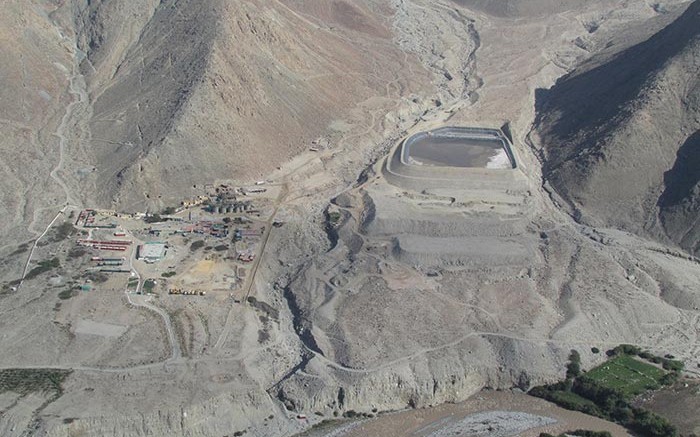At a time when many junior companies are dropping like flies, Dynacor Gold Mines (TSX: DNG: US-OTC: DNGDF) generates about US$700,000 to US$800,000 in cash flow per month, has about US$13.5 million in the bank, no debt, and plans to spend US$5 million on exploration this year at its Tumipampa project in Peru.
The Montreal-based company will spend another US$8 million in 2015 on building an ore-processing facility, its second in the country. This week, Dynacor received its final construction permit to build the mill near a city called Chala, about 600 km south of Lima, and expects it should be operating in about 12 months.
“It took us two years to get the construction permit but the important thing is we’ve got it,” Jean Martineau, the company’s president and chief executive officer, says enthusiastically in a telephone interview from Peru. “We are in a very comfortable position and for us. It’s a wonderful day.”
The 300-tonne-per day Chala mill will process gold from government-approved artisanal miners. Of the estimated US$10 million capex, Dynacor already has spent US$2.3 million on general infrastructure and equipment.
Dynacor’s first mill in Peru, called Huanca, about 450 km south of Lima in the Acari district, poured its first gold in 1998. Last year Huanca produced 68,923 oz. gold and Dynacor’s guidance for this year is for between 75,000 and 80,000 oz. gold. The mill has the capacity to run at a rate of 250-tonnes-per day, and Dynacor has applied to increase that rate to 300 tonnes per day, which it expects to be approved shortly.
The company estimates it will be able to process more than 102,000 tonnes of purchased ore per year at the new facility in Chala, and about 85,000 tonnes per year at Huanca.
“We are one of five completely permitted companies doing ore processing in Peru today and the other four are privately owned Peruvian companies,” Martineau says. “We don’t depend on the market to generate the cash we need.”
That means exploration can continue unfettered at its flagship Tumipampa property in the Peruvian Andes, 500 km southeast of Lima.
So far Dynacor has found a copper-gold skarn at the project and traced it for more than 4 km in length; uncovered more than 15 gold-silver veins; and identified disseminated gold mineralization.
Over the next 18 months, Dynacor plans to undertake 2,000 metres of underground development work including the excavation of cross-cuts, drifts and chimneys, and complete a 6,000-metre underground drill program, as well as a 1,500-metre drill program from surface targeting six geophysical anomalies and associated structures.
At the property Dynacor will continue geochemical sampling of the six chargeability anomalies in the disseminated gold zone, and carry out geophysical surveying to cover areas that have not yet been explored or mapped.
Following a geophysical survey in 2014, Dynacor launched a systematic surface sampling program targeting areas that showed high chargeability anomalies within the disseminated gold zone, which resulted in the discovery of four new high-grade-gold mineralized structures.
In February this year, Dynacor reported that channel samples that were taken from outcrops of the four structures returned assays of 35.58 grams gold per tonne over 0.30 metre; 31.16 grams gold over 0.35 metre and 22.09 grams gold over 0.30 metre; 10.94 grams gold over 0.30 metre; and 28.60 grams gold over 0.30 metre.
“We’ve done a lot of infrastructure work and a lot of surface sampling with geochemistry, almost 1,000 channel samples on surface, which isn’t very sexy for the market, but in doing that, we discovered new zones in the disseminated part, new veins, new mantos, exoskarn, a porphyry, a brecciated zone, all of which opens up huge potential,” Martineau says. “This year we should have a continuous stream of results and after that, we’re going to have enough results to complete our first 43-101 report.”
The company has also invested about US$400,000 to rebuild a road from the project to the town of Abancay.
The earliest exploration at Tumipampa dates to colonial times, with signs of adits and in-situ stockpiles of quartz fragments and oxide ore found near a river on the property. The company’s chief geologist, Alonso Sanchez, dates the igneous, sedimentary and metamorphic rocks back 11 million years.
The remote 48.4 sq. km property, 4,500 metres above sea level in a barren plateau, is situated at the contact between the Apurimac batholith, a geological structure where big copper porphyry skarns have been found, and a gold-silver belt to the south, where there are a lot of gold mines, Martineau says.
Surrounding projects and mines include MMG Limited’s Las Bambas project to the east; Southern Copper’s (NYSE: SCCO) Los Chancas project and Iamgold’s (TSX: IMG; NYSE: IAG) Maria project to the west; and Barrick Gold’s (TSX: ABX; NYSE-ABX) Lily project to the south. To the north and northeast are Minas Buenaventura’s (NYSE: BVN) Orcopampa mine; Hochschild Mining’s (LSE: HOC; US-OTC: HCHDF) Arcata and Pallancata projects; Hudbay Minerals’ (TSX: HBM; NYSE: HBM) Constancia mine; First Quantum Minerals’ (TSX: FM; LSE: FQM) Haquira project; and Bear Creek Mining’s (TSXV:BCM) Layeuga project.


Be the first to comment on "Dynacor’s milling strategy pays exploration costs"